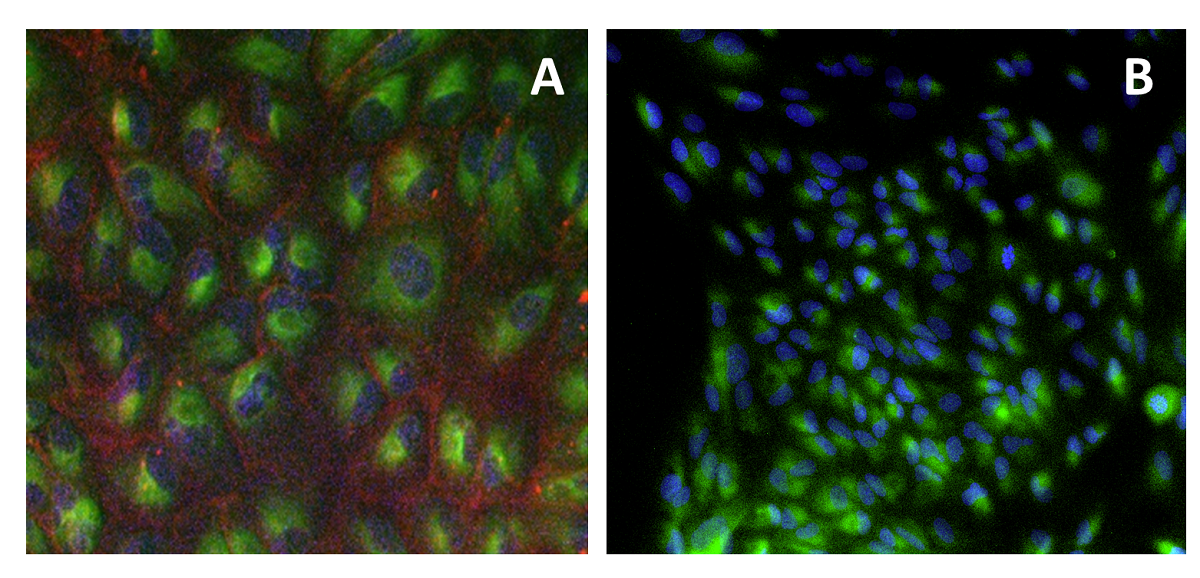Chemists and biologists from
St Petersburg University have developed new reagents based on heterocycloalkynes for reliable and safe attachment of fluorescent tags to biomolecules. The created compounds will help to visualise the processes occurring in cells and tissues of living organisms and to study their dynamics in real time.
Application of cyclononyne containing green fluorescent tag to modify and visualise with fluorescence microscopy HEK293 cancer cells metabolically-labeled by Azido-Glycans (A) and Azido-DNA (B).
The research results were published in the Journal of the American Chemical Society.
Modern scientists can investigate composition and changes in living cells using fluorescent bioimaging. This is a technique in which the molecules of interest in a living organism, such as proteins or DNA, are ‘illuminated’ with fluorescent dyes and made visible to screening systems by exposure to light of a particular wavelength.
The fluorescent tags and selected molecules need to be securely ‘cross-linked’ for bioimaging to be successful. Special chemical reactions are used for this purpose. In the opinion of Natalia Danilkina, Associate Professor in the Department of Organic Chemistry of St Petersburg University, the most demanded and balanced today are SPAAC reactions (strain-promoted azide-alkyne cycloaddition). They enable direct attachment of special reagents in cells to biopolymer molecules modified with azido groups, cycloalkanes containing a dye tag.
SPAAC is a biorthogonal click reaction, that is, a reaction capable of occurring in living cells but which is neither detrimental to them nor affected by living systems as such.
‘No toxic copper catalysts are required in these reactions and no by-products are involved. SPAAC reactions are extremely important for conducting biological experiments. The physiology of living cells and the processes occurring in them can be studied in this way, while also establishing the propensity of cells to transform into tumor cells,’ explained Natalia Danilkina, Associate Professor in the Department of Organic Chemistry of St Petersburg University.
As Natalia Danilkina noted, there are already several types of reagents based on cycloalkynes (molecules that have a closed cycle of carbon atoms with a triple carbon-carbon bond inside the cycle) on the market. However, scientists at St Petersburg University under the leadership of Irina Balova, Director of the Institute of Chemistry and Doctor of Chemistry, have succeeded in synthesising fundamentally new reagents. They are characterised by high availability and an optimum balance between reactivity in SPAAC and stability to the environment and other reagents.
Work on the new reagents took place in several stages. At first, the researchers developed a synthetic method for producing cycloalkynes. It allowed easy design and synthesis of a series of molecules with different cycle size (from eight to ten atoms) and special structural elements – heterocyclic ring and heteroatom (any atom except carbon or hydrogen) in cycloalkynes. These elements are important in regulating balance between activity in SPAAC and stability.
Chemists at St Petersburg University followed up by studying reactivity and stability of the synthesised compounds using kinetic investigations and quantum chemical calculations. The work was carried out at the St Petersburg University Research Park at: the Computing Centre; as well as at the resource centres ‘Chemical Analysis and Materials Research Centre’, ‘Magnetic Resonance Research Centre’, and ‘Centre for X-ray Diffraction Studies’.
According to Natalia Danilkina, experiments and calculations were instrumental in revealing non-classical reactivity of compounds with the cycles of nine atoms.
Usually, the larger the cycle, the lower the reactivity and the greater the stability of the compounds. In our case the stability really contrasted: eight-membered cycles were impossible to work with due to their instability, while nine-membered ones turned out to be stable.
Natalia Danilkina, Associate Professor at the Department of Organic Chemistry of St Petersburg University
‘However, the reactivity of eight-membered and nine-membered cycles was almost identical,’ explained Natalia Danilkina.
Based on these data, the scientists at St Petersburg University have found that heterocyclic heterocycloalkynes of nine atoms (cyclononines) are the most suitable for SPAAC. As Natalia Danilkina said, these compounds have the best balance between stability and reactivity. Whereas compounds with cycles of eight atoms (cyclooctines) are too unstable, and substances with ten atoms (cyclodecines) are nonreactive.
In the final stage, the researchers at St Petersburg University developed a method for attaching fluorescent dyes to a new group of reagents and conducted experiments to introduce the resulting compounds into cancer cell biomolecules. The research took place in the Laboratory of Biomedical Chemistry at St Petersburg University. The experiments confirmed the effectiveness of cycloalkynes with a nine-membered cycle for SPAAC. As Natalia Danilkina stated, St Petersburg University scientists can already use the new reagents for research in various areas.
The research team is currently working on refining the resulting substances. ‘Right now, it takes eight hours for a reaction to take place in a cell using our reagents. We aim to get that reactivity down as low as 15 minutes. We are testing all possible options for the structures with improved reactivity while maintaining stability. We are searching for the most efficient molecule. We are also selecting optimal ways to bind the reagents with fluorescent dyes and other groups,’ concluded Natalia Danilkina. She adds that the researchers plan to patent the technology in the future.
Our work is fully in line with the priority areas of the Strategy for Scientific and Technological Development of the Russian Federation and the St Petersburg University Strategic Plan, related to the transition to personalised medicine and high-tech healthcare.
‘The molecules we invent and synthesise are molecular tools for biologists and medical specialists. They enable them to investigate the molecular mechanisms of diseases and find effective methods of treating them,’ said Professor Irina Balova, Research Team Leader, Director of the Institute of Chemistry at St Petersburg University, Doctor of Chemistry.
The research was supported by the Russian Foundation for Basic Research (project No 20-03-00117) and the Russian Science Foundation (project No 21-13-00218 and project No 19-73-10077).
